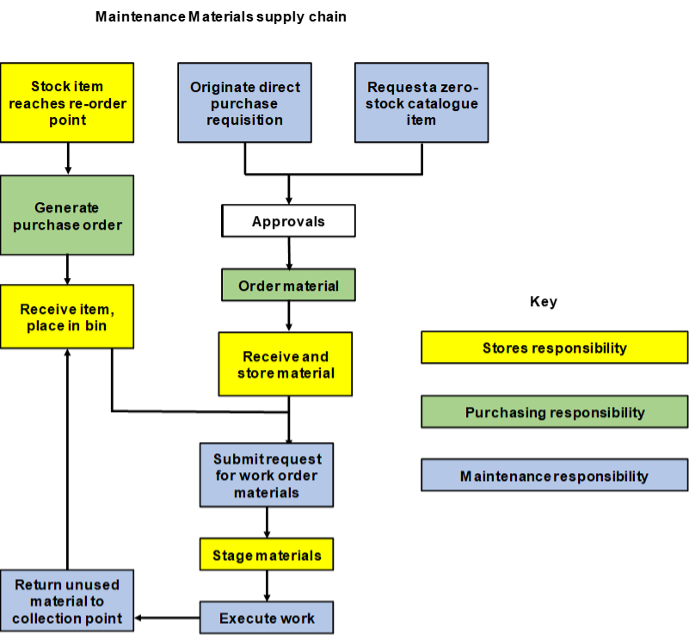What is the Role of a Maintenance Storeroom?
Don Armstrong, President of Veleda Services Ltd.
Posted 04/18/2023
In any organization there are many departments that must work closely with other departments. One vital partnership is maintenance and the maintenance storeroom – nothing is more important than getting the right parts at the right time to achieve a high level of maintenance effectiveness.
While this partnership is vital, it is difficult to develop and maintain because it requires a high level of discipline and determination by both parties. This article covers the dual responsibilities required to achieve success.
In my experience, many maintenance storeroom operations are ineffective. The focus is often placed on security: keeping the building locked, not allowing maintenance people to physically look for parts, and generally preventing losses. Sometimes the storeroom goals are completely out of sync with maintenance’s goals.
For example, maintenance storerooms may focus on reducing inventory without understanding the consequences. I’ve even seen instances where storerooms report to purchasing (stores and purchasing are very different functions) which in turn reports to a corporate “procurement” organization. A structure that makes maintenance storerooms “organizationally remote” from its customer will always create service problems.
To develop a picture of an effective maintenance storeroom, it’s good to start with these three principles:
- Maintenance storerooms should have complete business processes, standards, systems, facilities and staff to control and protect maintenance materials from the time they enter the premises until the time they are used on a maintenance job. This should include stocked materials, “zero-stock” catalogue materials, direct purchases and some special parts that may be stored outside of the storeroom building.
- Storerooms should make it as easy as possible for maintenance people to find, select, obtain and return the materials they need while always maintaining a high level of security. | Check out my next article to learn how to control materials returned to stores
- Materials should be stored and handled so that they will always be in a condition that will meet reliability goals when they leave storeroom control.
Following these principles, the “internal supply chain” for maintenance materials, with responsibilities, will look like this:

The implications of such a process are significant and require maintenance and the maintenance storeroom to work closely together to achieve success. For example, if the storeroom is to stage materials for maintenance work, as shown, maintenance MUST advise the storeroom of all the materials needed (a product of planning) and tell stores when it will be used (a product of scheduling).
Without proper planning and scheduling, staging material will be very difficult and certainly wasteful. This requirement means that the maintenance storeroom effectiveness is dependent on the discipline with which operations and maintenance can schedule maintenance work, and requires that scheduled work should be planned in detail.
Storerooms should support maintenance by providing the following services:
- A simple and robust way for maintenance people at all levels to find materials, supported by good naming standards, a comprehensive integrated “stock and non-stock” catalogue and willing help from storeroom staff when needed, all supported by a highly functional computer system.
- A well-managed “free issue” system for small parts.
- A suitable physical facility adequately staffed to securely store, protect, control, retrieve, stage, and deliver all stocked items and all direct purchased items.
- A secure location and facilities for staging “work order kits” for at least two weeks of non-shutdown maintenance work if a weekly work scheduling process is in use.
- A suitable physical facility to securely store, protect, control, retrieve and deliver all materials for planned shutdowns.
- A simple process to accept returned items and ensure that they are fit for re-stocking.
- A process to manage repairable and serialized spare parts.
- Record the location and movement of parts that are stored outside of the maintenance storeroom, with input from maintenance and operations people who are responsible for these parts.
- Sound basic inventory-management systems to immediately re-stock items that have reached their re-order point, replace items that have reached their shelf life and manage other basic inventory functions.
- Maintain an integrated catalogue of stocked and appropriate non-stock items, based on a naming standard that uses the same terminology as used by maintenance people.
- Investigate stock-outs and advise maintenance if they appear to be caused by equipment problems (e.g. increase usage) or by using maintenance stock for projects.
- Publish appropriate Key Performance Indicators that monitor storeroom performance.
Because the maintenance storeroom has the business processes to control the movement of materials, include all objects that are used by maintenance. This could include special tools and maintenance manuals, for these items it is especially important that the process is very simple, for example using a “tool tag” system and not the computer system.
Finally, to support maintenance and the maintenance storeroom in managing materials and tools, managers must ensure that the operation has a very high level of security and that any instances of theft of company property are dealt with in a manner that will strongly discourage any further theft.
If the maintenance “Statement of purpose” is “to provide our operating partners with a physical plant which, if operated correctly, will continue to meet all goals including production, quality, safety, and the environment at the lowest possible total cost over the long term” the storeroom Statement of Purpose should be “to provide our Maintenance partners with all the materials they need at the right time and the right place and in a condition to support reliability goals, all at the lowest possible cost over the long term”.
Read Don Armstrong’s next article to learn how to control materials returned to stores.

Don Armstrong
Don Armstrong is the President of Veleda Services – Maintenance Management Consulting and Training. Don is an experienced professional engineer and has managed a number of large maintenance departments over the years. In addition, he has successfully instituted new planning and scheduling processes, maintenance standards, and safety programs into maintenance departments.
Related Articles

How to Fix the 70/30 Phenomenon

Zen and the Art of Managing Maintenance

Why do maintenance improvement initiatives fail to deliver? (Hedgehog or Fox?)

Why Maintenance Improvement Efforts Fail

TPM and RCM: Whirled Class

Where Do Maintenance Professionals Come From?




